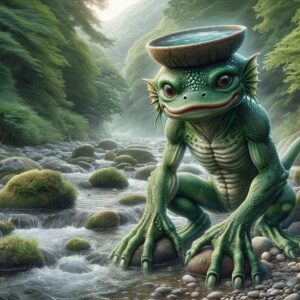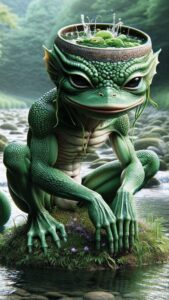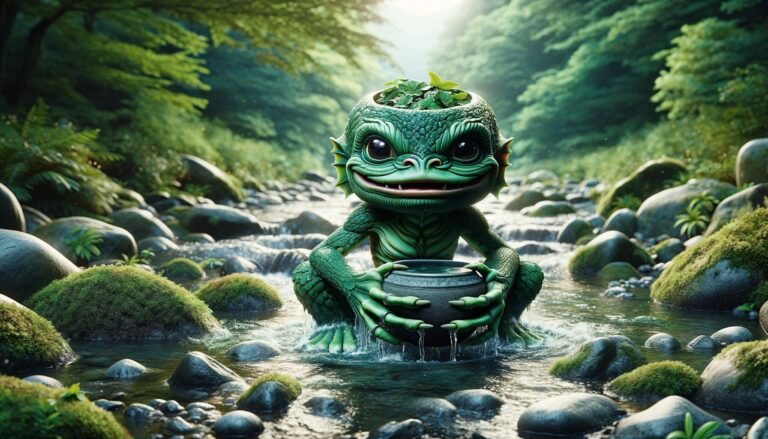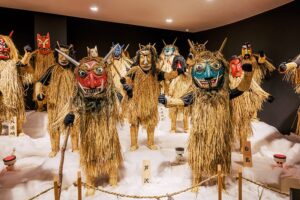Table of Contents
In the enigmatic waters of Japan, a creature lurks, equally mysterious and terrifying—the Kappa. This strange being is believed to possess magical powers that it can employ for both benevolent and malevolent purposes. Regrettably, the Kappa often chooses to utilize its gifts to play pranks on humans or unleash violent acts upon them. While skepticism regarding the Kappa’s existence persists, numerous sightings, especially in rural Japan, have kept the legend alive. Local residents even go to the extent of hanging warning signs near bodies of water believed to be frequented by the Kappa.
What is a Kappa?
The Kappa, a legendary monster, dwells in ponds and rivers across Japan. It possesses a hybrid appearance, blending humanoid and reptilian traits, and is infamous for its cunning. It goes by various names, including kawappa, gawappa, and kawaso.
Kappa: Mischief and Malevolence
In Japanese folklore, the Kappa is considered a type of suijin, a water deity residing in freshwater areas of Japan. Legend has it that Kappas delight in causing mischief and, at times, harm to humans. Their pranks can range from harmless jests such as mimicking flatulence sounds to more malevolent acts like peeping under a woman’s kimono. However, some Kappas are far more violent and have been documented attempting to drown livestock, kidnapping and consuming children, and assaulting women.
Although Kappas are generally regarded with fear, there are instances where they are considered benevolent, often when indebted to a human. Ancient Japanese legends attribute knowledge of bone setting and medicinal salves to friendly Kappas, highlighting their dual nature.
Characteristics of the Kappa
Physical Descriptions
Descriptions of Kappas exhibit regional variations but share common traits. Typically, Kappas are depicted as small, child-sized beings, never exceeding five feet in height, with relatively petite frames. The term “Kappa” roughly translates to “water child.” They possess webbed hands and feet, displaying exceptional swimming abilities.
Kappas feature scaly skin akin to reptiles, with varying colors such as yellow, green, and blue. Their humanoid figure bears a tortoise-like shell on their backs. Kappas are often depicted with long, unkempt hair resembling a bowl cut and a beak-like mouth. Intriguingly, this beak does not hinder their ability to speak human languages.
Most distinctively, all Kappas have a small, bowl-like depression on the top of their heads, called the “sara,” which holds a pool of water. This water source is believed to be the wellspring of their magical powers. Whenever a Kappa ventures onto land, it must keep its sara filled; failure to do so results in the loss of strength and magical abilities. Refilling a Kappa’s sara is said to earn eternal gratitude and assistance for a lifetime.
There are accounts of a specific hairy variety of Kappa known as “hyosube,” resembling voracious ogre-like monsters.
Personality and Behavior

Kappas are infamous for their malevolent disposition, often directing their ire toward humans and livestock. Some Kappas are known as pranksters who engage in crude humor like producing flatulence-like sounds or indulging in voyeuristic acts. Others, however, display more violent tendencies, including attempts to drown livestock, consumption of victims’ blood, and sexual assaults on women.
Legend holds that Kappas fixate on acquiring an object known as “shirikodama,” a mysterious jewel believed to house a person’s life force found in the “shiri” or anus. While many Kappa attacks aim to obtain this shirikodama, not all Kappa killings share this motive. Alarmingly, certain tales recount Kappas lurking in toilets, ready to sexually assault women. These victims reportedly bore Kappa children, who, due to their gruesome appearance, were dismembered and interred in jars.
Despite their malevolence, Kappas are strangely bound by a sense of politeness and adherence to human traditions, which serves as their chief weakness. Encounters often involve a showdown of manners, with those who outwit Kappas causing them to spill the water in their sara, rendering them powerless. Kappas are also considered highly trustworthy and honest. Refilling a Kappa’s sara invokes a sense of obligation, leading them to grant favors or fulfill promises.
Powers and Abilities
Kappas possess a range of powers believed to be magical and revered by their believers. These include extraordinary strength and exceptional swimming capabilities. Additionally, Kappas have an affinity for combat, particularly sumo wrestling, which they relish. Notably, the greatest joy in a Kappa’s life is often engaging in combat with victims. However, potential combatants can escape this fate by bowing deeply to the Kappa, triggering a return bow that results in spilled sara water.
Kappas are also known for their intelligence. They are credited with introducing various medical practices to ancient Japanese societies, including the art of bone setting and the creation of medicinal salves. Building a friendship with a Kappa may result in the bestowal of profound medical knowledge.
How to Defeat a Kappa

Several methods are believed to fend off or defeat a Kappa. The most common tactic exploits the Kappa’s obsession with politeness and adherence to human customs. When encountering a Kappa, one should bow deeply. In response, the Kappa will reciprocate the bow, spilling the water in its sara and rendering itself powerless. However, some Kappas have learned to protect their sara using a metal plate during land excursions.
For Kappas who shield their sara with a plate, alternative approaches are needed. One such method involves the Kappa’s easily detachable arms. Swift individuals can grab a Kappa’s arm during combat, pull it off, and negotiate with the Kappa in exchange for its return. Numerous Japanese legends recount heroes who used this strategy to secure the safety of their entire village.
Other means of repelling Kappas center around their culinary preferences, particularly cucumbers. Cucumbers are believed to be one of the few things Kappas love more than the internal organs of young children. Writing the names and ages of family members on cucumber slices and tossing them into the water before bathing is thought to safeguard one’s family. However, opinions vary on whether consuming cucumbers ensures safe passage in water, with some regions advocating its protection and others predicting inevitable Kappa attacks.
Carrying iron, sesame, or ginger is another reported method to ward off Kappas.
Related Characters and Explanations of the Myth

Some propose that Kappa legends originate from encounters with extraterrestrial beings that navigated to Earth. Advocates of this theory contend that these aquatic aliens possess the ability to traverse between Earth and their realms through portals, offering an explanation for their elusive presence. Whirlpools and robust water currents, recurring motifs in mythology, are posited as physical manifestations of these interdimensional gateways. Numerous ancient cultures recount narratives of aquatic creatures descending from the heavens, promptly submerging themselves upon arrival. These entities, alongside gods and goddesses, are attributed with instructing humanity in diverse realms, including culture, religion, and medicine. This aligns with the Kappa’s role as benevolent aides who bestowed medical wisdom, such as bone-setting techniques, upon early Japanese communities.
Leech Babies
An alternative theory posits that Kappa legends emerged as a means to deter children from venturing near bodies of water, where they might encounter gruesome sights known as “leech babies.” Leech babies were either stillborn or newborn infants tragically discarded by impoverished families unable to care for them. These unfortunate infants were often disposed of in rivers, lakes, and ponds—locations associated with Kappa sightings.
In the ancient world, encountering a leech baby was not uncommon due to the prevalence of struggling families who lacked the means to provide for their offspring. The Kappa legend, whether intended to serve as a cautionary tale for disobedient children or an explanation for the distressing sight that could traumatize ancient Japanese youth, is often traced back to these leech babies as the origin of the myth.
The Japanese Giant Salamander
Another hypothesis suggests that the Kappa legend may have arisen from the fear of encountering the Japanese giant salamander. These sizable amphibians can reach lengths of up to five feet and possess skin tones reminiscent of the Kappa. Japanese giant salamanders are known for their powerful jaws, with a propensity for seizing prey and dragging them into the water. Intriguingly, these salamanders frequent the same aquatic habitats—rivers, lakes, and ponds—associated with Kappa sightings.
Intriguingly, there are undeniable parallels between the behavior and appearance of these amphibians and the Kappa, sparking speculation that the legend may have evolved from encounters with these creatures.
Similarities:
Bunyip (Australian Aboriginal Mythology): The Bunyip is a water creature in Australian Aboriginal mythology, often described as inhabiting swamps, rivers, and billabongs. Like the Kappa, the Bunyip is associated with water bodies and is believed to have both harmful and helpful aspects.
Näkki (Finnish Mythology): Näkki is a water spirit in Finnish mythology known for its mischievous and dangerous nature. It resides in bodies of water like lakes and rivers, where it may lure people to their doom. Similar to Kappa, Näkki has both positive and negative aspects.
Lusi (Indonesian Mythology): Lusi is a creature from Indonesian folklore that dwells in the water, particularly in ponds and lakes. It is often portrayed as a malevolent spirit that can cause harm to those who encounter it.
Grindylow (English Folklore): In English folklore, the Grindylow is a water spirit known for its malicious behavior. It is said to inhabit bodies of water, such as ponds and marshes, where it may harm humans, especially children.
Nix (Norse Mythology): Nix creatures are found in Norse mythology and are known for their beautiful appearances and the ability to lure people, especially women and children, to the water’s edge with their sweet melodies. Some malevolent Nix were known to drown their victims, while others meant no harm and even married humans.
Siyokoy (Philippine Mythology): Siyokoy creatures in the Philippines share characteristics with Kappas. They are humanoid in appearance, have scaly green skin, and possess webbed hands and feet. Siyokoy are known to drown and eat humans, often accompanied by creatures like eels, rays, and squid.
FAQ
What does a Kappa look like?
Kappas are described as humanoid reptilian beings with webbed hands and feet, scaly skin, a tortoise shell on their back, and a bowl-like dent on their head called a "sara."
Are Kappas friendly?
Kappas are generally mischievous and often play pranks on humans, but they can also be helpful when indebted to someone.
What do Kappas eat?
Kappas are believed to enjoy cucumbers and occasionally the internal organs of young children.
How can you defeat a Kappa?
You can defeat a Kappa by making it bow deeply, causing it to spill the water in its "sara," rendering it powerless. Removing its arm or using items like iron, sesame, or ginger can also deter them.
Are Kappas related to other mythological creatures?
Some believe that Kappas have counterparts in other cultures, such as the Nix in Norse mythology or the Siyokoy in the Philippines.
What is the significance of the Kappa's "shirikodama"?
The "shirikodama" is a jewel believed to contain a person's life force, and Kappas are fixated on obtaining it.
Do Kappas have any positive qualities?
Kappas are known to be knowledgeable in medical practices and are considered extremely trustworthy and honest.
Are there any real-life creatures that resemble Kappas?
Some suggest that the Japanese giant salamander may have contributed to Kappa legends due to its appearance and behavior.




